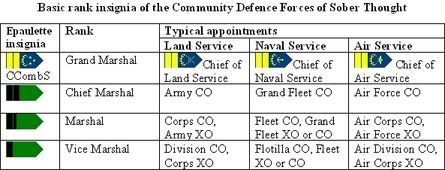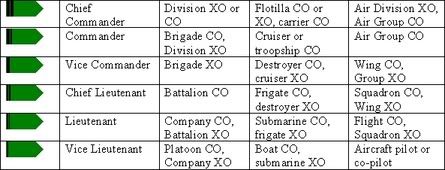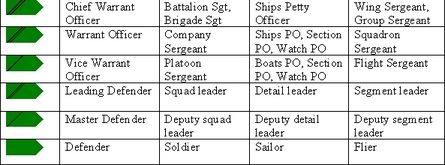Community Defence Forces
The Community Defence Forces are the all-environment armed forces of Sober Thought. Service in peacetime is voluntary.
Contents
Integrated strategic command
The nominal Commander-in-Chief of the CDF is the Community Conscience of Sober Thought. In practice, control is exercised by the Combined Staff containing the five most senior marshals of the CDF. The five positions are Chief of the Combined Staff, Deputy Chief of the Combined Staff, Chief of the Land Service, Chief of the Naval Service and Chief of the Air Service, and only the latter three must have had their main military experience serving with the environment they represent.
The combined staff is tasked with recruiting, training and organizing troops. It also makes strategic plans, then assigns the operational plans to the command, formation or unit it has designated to execute it. The chief of each of the three environments have only a support role and do not interfere with operations directly.
Integrated operational command
It is a central principle of the CDF that those who make operational plans should execute them. Therefore, the subordinate commanders of the Combined Staff actually make the detailed plans and put them into practice so that staff errors are borne by themselves in combat.
As an integrated armed forces, operational commands may combine air, sea and land elements responsible to a single commander for all services. Furthermore, after the House of the Provinces has voted to make it so, the provincial Civil Guards may be directly integrated into the CDF for tactical or strategic purposes. Formations and task forces of all sizes are quickly created and all elements fall under the command of a single person.
One permanent example of this in action is the Coastal Defence Command, which combines Coastal Defence Air Groups of the Air Service, Coastal Artillery Divisions of the Land Service and Independent Coastal Task Forces of the Naval Service. A landing ship group's vice commander has three principal subordinates and groups of troops: the chief lieutenant of the ship with 100 sailors, the chief lieutenant of the Marine Assault Companies with 250 soldiers and the chief lieutenant of the Composite Helictoper Squadron with 100 fliers.
Land Service
Combat units in the land forces are organized on the following basis, listing unit or formation, number of soldiers and commanding officer:
Platoon 20-40 Vice Lieutenant Company 50-250 Lieutenant or Chief Lieutenant Battalion 300-800 Chief Lieutenant or Vice Commander Brigade 1 000-4 000 Commander Brigade Group 2 000-6 000 Chief Commander Division 8 000-18 000 Vice Marshal or Chief Commander Corps 20 000-70 000 Marshal Army 120 000-300 000 Chief Marshal Army Group 400 000+ Chief Marshal or Grand Marshal
Units are usually permanent groupings of personnel, typically battalions or (less commonly) companies. Formations may be very transient groupings of several or many units.
For every 100 million of Sober Thought's population, there are the following number of Regular Force combat brigades: 12 armoured, 15 infantry brigades (including one each of marine armoured infantry, marine light infantry, airborne and mountain), 16 artillery (including three coastal). Additionally, the provinces' Civil Guards provide 9 infantry (including one mountain) and 1 artillery brigades.
Most of these LS and CG brigades are organized into nine divisions. Disregarding the divisional air wing, four divisions consist entirely of regular troops, one division of Central Province Civil Guards and four divisions of a combination of regulars and Guards. Three divisions plus one armoured or armoured infantry, one artillery and one support brigades are commanded by the corps' marshal. The three corps plus an airborne brigade group, an armoured brigade group, an engineering brigade and two support brigades are commanded by the army's chief marshal.
The marine division exists outside this organization and is operationally responsible to the Chief of the Naval Service where it is described.
Civil Guard
Each province maintains its own Civil Guard comprised of part-time citizen soldiers organized into territorial regiments with the same structure, equipment and arms as the Land Service proper. The Civil Guards are armed and trained by the federal troops of the Land Service, but they are paid by their respective provincial governments.
The provincial government directs its Civil Guard and may call it out in times of unrest or emergency in the province. Following authorization by the House of the Provinces, the federal government may also call some or all of them out for service with the CDF in times of war or tension. When the Land Service fully mobilizes, Civil Guard units and formations form the vast bulk of two and about half of three land divisions.
The provinces recruit their own residents into their Civil Guards using the general CDF qualifications and standards. The provincial government promotes those in the Master Soldier, Leading Soldier and the three lieutenant ranks. It may also promote successful graduates of appropriate CDF courses in the six warrant officer and commander ranks. The CDF alone promotes officers in the marshal ranks.
Obviously, the size of the civil guard differs as widely as the population of each of the provinces. However, for each one hundred million of national population, the following Civil Guard battalions (and the formations in the first wave) are raised:
- Central Province; 37; 9th Division, one brigade of 6th Division, independent mountain brigade
- Hochelaga; 23; vast bulk of 8th Division
- Thuvia; 13; three brigades, two in the 7th Division
- Western Province; 10; two brigades in the 7th Division
- Jarvet; 3; bulk of armoured infantry brigade of 6th Division
- Plains Province; 3; elements of 6th Division
- South Island; 3; elements of 5th Division
- Capital Province; 2; not incorporated into field army, remain in capital
- Braunekuste; 2; elements of 5th Division
- North Island; 2; elements of 5th Division
- Potato Island; 1; elements of 5th Division
Air Service
The basic fighting unit of the Air Service is the squadron, except in naval aviation where flights and detachments are more common. When units serve alone, they have the supporting ground crew directly responsible to the squadron (flight or detachment) leader. When units serve together in formations, the ground crew are hived off and the squadron becomes solely a flight unit.
Below are air service units or formations, aircraft, personnel (independent and formation) and commanders:
Detachment 1 aircraft 10-50 1-15 Vice Lieutenant Flight 2-5 aircraft 30-100 2-50 Lieutenant Squadron 6-18 aircraft 100-500 6-100 Chief Lieutenant Wing 15-40 aircraft 200-1 500 18-200 Vice Commander Air Group 50-100 aircraft 2 000-4 000 50-400 Commander or Chief Commander Air Division 200-400 aircraft 5 000-10 000 200-2 000 Vice Marshal or Chief Commander Air Corps 400-600 aircraft 12 000-20 000 Marshal Air Force 600+ aircraft 20 000-40 000 Chief Marshal
The Air Service provides considerable air support to its Land Service and Naval Service counterparts, and these air assests are organized and suborinated to the other services. The "real" air service is called the Strategic Air Corps (or Force, depending on its size).
For every 100 million of population, the Air Service contributes the following squadrons (Strategic Air Corps/Army Air Corps/Naval Air Division):
Jet
6/0/0 bomber 30/3/12 fighter 0/9/0 tank busting 0/4/0 strategic transport 1/0/0 strategic reconnaissance 2/4/0 tactical reconnaissance 1/1/1 strategic airborne warning and control 0/1/0.3 tactical airborne warning and control 1/1/0 radar jamming 0/0/0.3 carrierborne radar jamming 3/1/1 in-flight refuelling tanker 0/0/0.7 carrierborne refuelling tanker
Propeller
0/3/0 gunship 0/9/0 tactical transport 0/0/3 maritime patrol
Helicopter
0/9/0 ground attack 0/0/12 naval composite (attack, utility and transport) 0/0/12 naval utility (6 squadrons search and rescue only) 0/12/0 land utility 0/12/0 land transport
The Strategic Air Corps organizes its squadrons into two fighter air divisions, a bomber air group, a reconnaissance wing and tanker wing. The Army Air Corps organizses its squadrons into three corps air divisions and an army air division. Practical control is exercised by the Land Service's corps and army commanders, respectively. The Naval Air Division organizes its squadrons into a carrier air group, a coastal defence air group, a landing ship helicopter group, a naval escort helicopter wing and a naval transport helicopter wing. Practical control is exercised by the Naval Service's senior officer afloat or Coastal Defence Command as applicable.
For every one hundred million citizens in Sober Thought, the Naval Service commissions the following (number of ships or boats, type, displacement, total crew (overall ranking officer), naval crew (ranking officer) + embarked air crew (ranking officer) + embarked land (ranking officer):
Combat Ships
1 aircraft carrier, 70 000 tonnes, ~5 000 (Chief Commander) ~2 000 (Commander) + ~2 300 (Commander) + 515 (Chief Lieutenant) 6 missile cruisers, 11 000 tonnes, 530 (Commander) 385 (Commander) + 30 (Lieutenant) + 115 (Lieutenant) 12 missile destroyers, 5 400 tonnes, 330 (Vice Commander) 265 (Vice Commander) + 30 (Lieutenant) + 35 (Vice Lieutenant) 24 anti-submarine frigates, 4 000 tonnes, 220 (Chief Officer) 189 (Chief Officer) + 20 (Vice Lieutenant) + 11 (Leading Soldier) 24 patrol submarines, 2 400 tonnes (dived), 50 (Lieutenant) 12 fast patrol boats, 400 tonnes, 35 (Vice Lieutenant) 9 mine sweeping and laying boats, 800 tonnes, 30 (Vice Lieutenant)
Combined Operations and Support Ships
1 troop transport, up to 5600 (Chief Commander) 500 (Commander) + 80 (Lieutenant) + up to 5 000 (Commander or Chief Commander) 9 assault landing ships, 2 200 tonnes, 450 (Vice Commander) 100 (Chief Lieutenant) + 100 (Chief Lieutenant) + 250 (Chief Lieutenant) 9 supply ships, 80 (Lieutenant) 2 small craft tenders (frigate hulls), 4 000 tonnes, 150 (Chief Lieutenant) 120 (Chief Lieutenant) + 30 (Lieutenant)
To the nearest thousand, for every 1 000 000 citizens there are about 17 000 sailors, 5 000 naval fliers and 4 000 marines afloat, plus 35 000, 22 000 and 32 000 ashore totalling 52 000, 27 000 and 43 000.
Ranks and typical posting
As befitting a unified service, the ranks for officers are identical for those in the Land Service, Naval Service and Air Service. There are slight differences for non-officers in both rank and appointment.
Each of the three services refers to the ranking officer in a formation or unit as "commanding officer," with the Naval Service occasionally using "captain" as a synonym. Since there are no ranks of captain, this causes no confusion. The second ranking officer or deputy commanding officer is called "executive officer."
The most senior officers are the four marshal ranks, generally commanding a large formation intended to operate without outside assistance. The mid-level officers are the three commander ranks, generally commanding a small formation or unit intended to operate as part of a larger formation. The junior officers are the three lieutenant ranks, generally commanding a small unit or sub-unit reporting to a larger formation or unit.
All troops show rank on their epaulettes, along with insignia indicating branch or service. Field uniforms are olive green and dress uniforms mid-blue. Troops serving with the Combined Staff always have their branches and ranks in gold. Other troops always have their branches in grey, and their ranks in black for field and white for dress uniforms.



Among the three classes of warrant officers (comparable to senior non-commissioned officers in some other armed forces), there are a number of distinguishing geometric figures below their epaulette stripe. Among Vice Warrant Officers, an equilateral triangle indicates a Platoon Sergeant (land), a Flight Sergeant (air) and a Section Petty Officer (navy), and an equilateral triangle on a base of a semi-circle a Watch Petty Officer (navy).
Among Warrant Officers, a square indicates a Company Sergeant (land), a Squadron Sergeant (air) and a Boats Petty Officer (navy), and a square on a base of a semi-circle a Watch Petty Officer (navy).
Among Chief Warrant Officers, a pentagon indicates a Battalion Sergeant (land) and a Wing Sergeant (air), a diamond a Ships Petty Officer, and a hexagon a Brigade Sergeant (land) and a Group Sergeant (air).





The ranks equivalent to junior NCOs are Leading Defender (non-specific DF), Leading Soldier (land), Leading Sailor (naval), Leading Flier (air), Master Defender, Master Soldier, Master Sailor and Master Flier. The ranks equivalent to private soldiers are Defender, Solider, Sailor and Flier.
